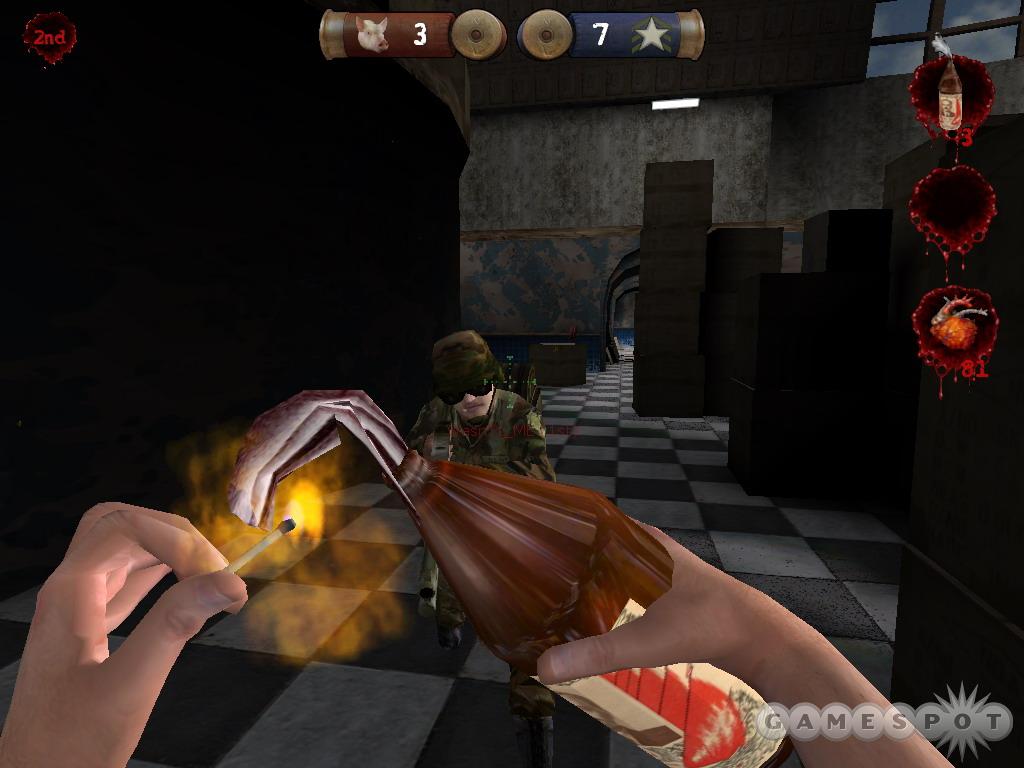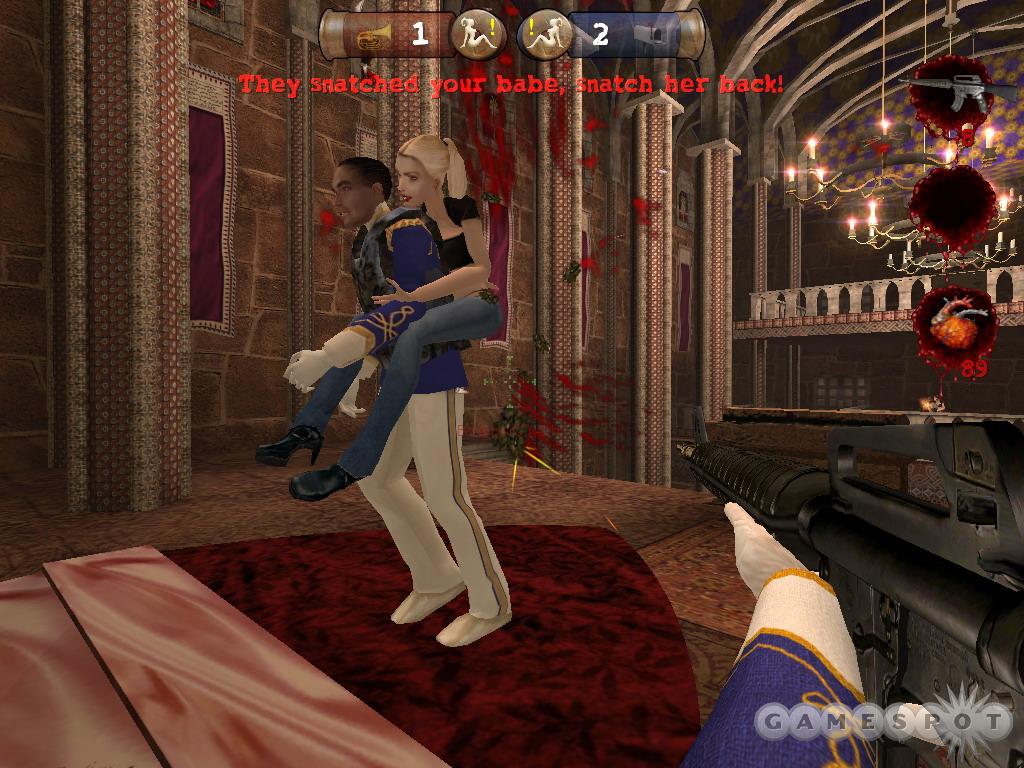Last April's Postal 2 seemed to purposely divide gamers into a "love it" or "hate it" camp, the latter of which was considerably larger. The sequel to the controversial 1997 shooter promised to be even more offensive than its predecessor, and it did in fact deliver tons of gross-out humor, racist jokes, and gory violence, all while being perfectly flippant about it. Truthfully, Postal 2's content wasn't far in excess of what you could find on a typical episode of South Park. Yet while the game flaunted its naughtiness, it unfortunately didn't offer enough in the way of entertaining gameplay or longevity to justify all the irreverence. More than half a year later, a rerelease titled Postal 2: Share the Pain addresses the most glaring technical issue of the original--the painfully long loading times between gameplay areas--and adds some goofy multiplayer modes (those who already own Postal 2 can get the multiplayer upgrade at a discount, though it was initially promised as a free download). The result isn't going to convince anyone who took Postal 2 the wrong way to give it a second chance, but it's a better game now than before, and those looking for some seriously lowbrow humor in first-person shooter form would likely get a kick out of it.

The single-player portion of Postal 2: Share the Pain is largely the same as before. Rather than adopt the conventionally linear structure of most first-person shooters, Postal 2 has a more open-ended structure reminiscent of the recent Grand Theft Auto games, only you're stuck running around on foot. The cars lining the streets are apparently just there to mock you. As The Postal Dude (that's actually his name), you're tasked with completing a series of mundane errands over the course of a work week. You may attempt to complete these errands conventionally--for example, on Monday all you need to do is collect your paycheck, cash it, and then buy a carton of milk--but you'll probably end up resorting to violence, and not just because you can. As the week goes on, certain factions will automatically get on Dude's bad side, so going through the game without killing anybody becomes practically impossible after a while. Also, the freedom to explore the town of Paradise is undermined somewhat by the loading times that crop up in between relatively small sections of town. Again, these are shorter and definitely more tolerable than before, which makes the game less frustrating to play, but you'll still find yourself plotting routes through town that require you to go through as few of these transitions as possible.
Mechanically, Postal 2 plays like a straightforward first-person shooter. There's a pretty conventional array of weapons to collect, and you don't even have to worry about reloading these, though you'll instead need to be careful about brandishing them in public (unless you intend to use them). Some of the later weapons are more interesting, such as the napalm launcher and, everyone's favorite, the diseased cow head. But the citizens of Paradise never pose much of a challenge and are usually content to just stand there and get their heads blown off. Some rag-doll physics and even a Max Payne 2-style slow-motion power-up (an effect that Postal 2 did first, for what it's worth) can make the gory action entertainingly over-the-top for a while, but it's probably too simple to hold anyone's interest for long.
Postal 2 is mostly just an excuse to set up a lot of goofy, purposely offensive gags, and some of these can be funny, while many of them fall flat. The Postal Dude himself, for instance, has the voice of a radio disc jockey, and he sounds out of place as he forces cusswords out at every opportunity. On the other hand, when he's out looking for the perfect Christmas tree or trying to get Paradise citizens to sign a political petition or a few other such occasions, you might get a laugh. At any rate, you could easily finish Postal 2's entire single-player portion in a weekend or even in a day, though some cheat codes and multiple difficulty settings are available to implore you to give it another whirl. Share the Pain adds a few new areas and a couple of new, higher difficulty modes to the single-player portion of the game, but these don't really do much to extend its value.
The four different multiplayer modes honestly don't do much to extend the game's value, either, largely because not many people are playing them. Still, a built-in server browser theoretically makes it easy to hop into an online session, and if you host a game session, you can throw in some computer-controlled bots (which the game calls "morons") if you want more targets to shoot at. Your main modes here are conventional deathmatch, team deathmatch, and a capture-the-flag variant called "snatch," in which the "flag" is a scantily clad woman who piggyback rides on whomever picks her up. Snatch and team deathmatch seem to be the most popular modes, relatively speaking, whereas the "grab" mode, in which players battle to collect a series of power-ups, doesn't seem to be much of a draw. There are more than a dozen different multiplayer maps, all seemingly based on areas from the single-player game, and while most of the maps are pretty basic, they're reasonably varied, and a few stand out. Also, a few of Postal 2's more-unusual gameplay features, such as the ability to urinate on anything at any time and the ability to commit suicide by detonating a grenade in one's mouth at the touch of a button, can actually come into play during multiplayer, lending the action a decidedly different tone than what you may be used to.

Postal 2 still looks quite good, at least when you're running around outdoors, and the game's characters have a decent range of expressions and animations. Plus, in classic Duke Nukem 3D style, there are lots of sight gags to be found. Indoors, the game doesn't look as attractive, and here you'll notice that the level architecture is very simple and a lot of texture maps are overused. Not that it really matters. The game's audio is also rather mixed, since not only does The Postal Dude just not sound right, but a lot of the game's weapons sound rather underpowered, which is surprising for a game that features plenty of gratuitous violence. Also, there's almost no music in Postal 2, so you'll often be running around in relative silence.
Moral judgments aside, Postal 2: Share the Pain certainly isn't a bad game. It at least tries to put a slightly original twist on first-person shooters by letting you explore (and open fire) at your leisure, and there's simply a lot of stuff to see in Paradise. The multiplayer portion of Share the Pain is OK, too, though it probably would have had more of an impact had it been included with the original version of Postal 2. In fact, it may seem strange to put it this way, but Postal 2: Share the Pain is the game that Postal 2 probably should have been in the first place.
Editor's note 01/21/04: The review originally stated that the multiplayer content of Postal 2: Share the Pain was available as a free download to owners of the original Postal 2 game, which is incorrect. GameSpot regrets the error.